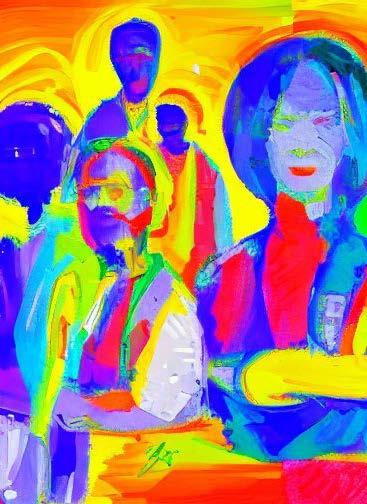
25 minute read
Work, Reinvented: How Generative AI is Reshaping Careers
The ongoing development and proliferation of generative AI has led to both trepidation and excitement about its impacts on work and the workplace. As employers begin to evaluate the myriad of opportunities presented by the integration of generative AI systems into their working practices, the increasing expectationin some areas already beginning to be realisedthat AI will fundamentally alter working life and disrupt a multitude of tasks, roles, and careers across a range of sectors has understandably led to fears among employees. Perhaps the most widespread, and the most frightening, is the fear of replacement; as when any technological advance promises to automate tasks that fell previously under the exclusive domain of human activity, the new integration of these technologies will fundamentally alter the way we go about our day-to-day tasks. This incoming change has, understandably, fed into fears surrounding the future of work.
However, while many remain cautious, there are optimists who are inviting this change with welcome arms. The automation of basic routines and tasks has the potential to increase productivity, and leave more time for creative and critical thinking skills which are unlikely to fully replicated by AI systems. So, while certain skills and roles may become redundant, otherpotentially more fulfilling - outlets will emerge, which will continue to require our human touch. As we adapt and integrate generative AI into our work we will need ask: what shifts will emerge as certain skills and roles are automated? What steps can we take to mitigate the negative consequences of this transition? And, most importantly, how will we use our time, skills, and human touch to remodel our purpose in the workplace?
Advertisement
The following interviews tackle fundamental questions surrounding the future of work, the integration of generative AI into the workplace and the potential for fostering creativity through generative AI. We interviewed the artist - Noël Baker, and engineer Ole Haaland, who are optimistic about the opportunities unfolding with generative AI. Instead of trepidation, Ole and Noël ask us to be open to these technologies and grow alongside them.
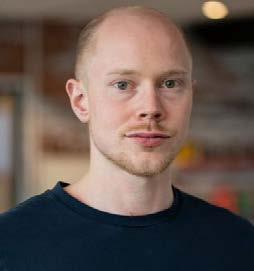
Ole Haaland Robotics Engineer
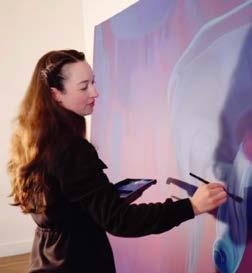
Noël C. Baker, PhD. Artist, Climate Scientist
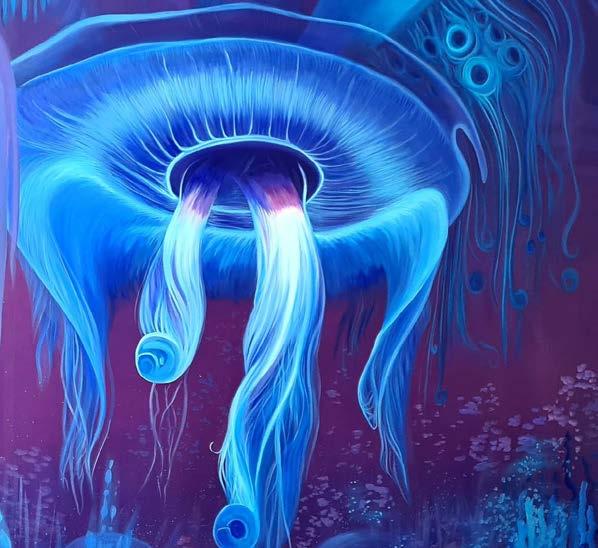
Artwork by Noël C. Baker
At the Intersection of Art and AI
A Conversation with Noël Baker
How are you incorporating generative AI into your artwork? How did you first start thinking about AI in relation to art?
I see generative AI as a tool, rather than the artist, just like any tool that’s come about in the art world or to humanity in general. It’s not like I’m using what AI generates, and that’s the art and that’s done. What I do is I use it as a tool to help me imagine, to give me different possibilities and take inspiration from. I use it to make a painting of my own creation; at no point is it a direct copy of something else. So it’s almost a collaboration more than it is a generation of art, because the end product is inspired by what I ask the AI to produce.
I’ve done a few art exhibitions, and I’m working on one big expo that’s coming up from April to June in Brussels, called “Seas & Oceans” (pictured above). And one of my main involvements with generative AI is the huge art piece I’m doing for this expo.
As a climate scientist, I wanted to talk about my relationship with environmental grief, and the experiences that I’ve had as a scientist being exposed to the changing environments, and the impact that humanity has on the degradation of the natural world. Through art, I imagine a world after climate change has occurred, after humanity has done the worst that we can do, to the point that humanity has killed itself off and most of the species on the planet. And all that’s left in the seas and oceans are species that could survive the impacts of climate change on the oceans which are warmer waters, higher dissolved carbon, basically a more acidic, warmer environment. I was trying to imagine what this would look like. A world after all of the species that we know and are familiar with have died off, and new species have evolved from the resilient ones that were able to survive climate change. So I wanted creatures that don’t currently exist, that have never existed on the planet.
So, I asked AI to generate creatures for me. The generative AI creates its own interpretation, where things are changed and warped. They are a little bit off and different, but still realistic enough that you can imagine them being real creatures. It ended up being the perfect collaboration, and I used these bizarre AI output creatures to populate my underwater world.
I must have spent 30-40 hours playing with the AI generator to get all these different creatures. And I went through hundreds and hundreds of different AI generated images to find the ones that I liked. And then I combined, and mixed, and just created this whole imagined new world.
A lot of it was just wanting to play and have fun, which is one of the joys of art; I see it as an opportunity to try and expand our horizons. Isn’t that really what art is about?
How do you see the role of generative AI in the art community?
AI used to be a tool that artists didn’t pay much attention to. But now it’s becoming so big that it has begun to threaten certain art communities. As an example, a friend of mine is a purely digital artist who doesn’t do any traditional painting on canvas; everything is done with a computer on a graphic design program. She feels deeply threatened by AI because everything she does can be reproduced to some reasonable-quality amount by AI.
This is a very serious threat for digital artists because their art can be used as training sets for the AI, and an artist’s style can be reproduced with exceptionally good fidelity to the point that you cannot distinguish what the AI produces from the artist’s original work.
I can understand why she feels threatened by the proliferation of generative AI. But my perspective is very different, and I think this is because I’m not a purely digital artist. Most of my art is paint on canvas. So, I don’t feel the same existential threat from AI. But I also feel like my approach and my perspective towards AI is more of the way a scientist might approach it. I’m not worried about AI because I use it purely as a tool.

Artwork by Noël C. Baker
Do you think there a way to misuse generative AI as a tool in the artworld?
Well, it’s an interesting question from the overall perspective of art. I like to look at it in the way we think of art history. So, consider a Renaissance artwork. It’s sometimes taken to be the ‘purest’ form of art. They look at a subject and create incredible lifelike portraits. But even they used a lot of tools and tricks. So even back during the golden age of the Renaissance, there is evidence that they used what technology they had at the time: optical instruments, mirrors, even projection technology to trace the images of what they were seeing directly onto the canvas.
Of course, they have wonderful skills to make the portrait realistic, but they’re skipping a lot of the painful process of getting the proportions.
So, what is pure art that’s untouched by technology?
At every step of the way along the path of art all the way up to now, with any tool that has been introduced, some people are going to say, oh, this is going to ruin art, this is going to ruin the whole industry, it’s going to ruin what makes an artist pure. There are always going to be people who are afraid of it or who say that this is the end and we’re never going to have purity like we once did. And while I understand there are serious problems with AI and art, I think it’s largely confined to the digital artist’s perspective.
In my opinion, generative AI is like any other technology: it can be used in the right way and in the wrong way, and the user should be given the knowledge and ability to make that decision to use it the best way they can.
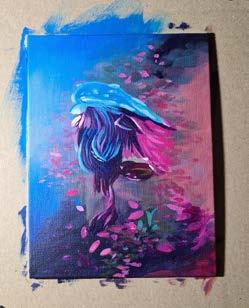
Artwork by Noël C. Baker
What kind of opportunities do you see in using generative AI as a tool in your art? What are you excited about around having this onset of generative imagery for artists?
Accessibility is definitely the first one. Going back to my friends, the Renaissance artists. It used to be that if you wanted to become an artist, you would either have to be rich with a lot of free time on your hands, or you’d have to study for years. It was only something that was available to those few students who could study under those few masters.
Now that accessibility is open to anybody with an internet connection, which is just tremendous. I mean, the fact that anyone can pick up a pencil and paper is already a wonderful thing about art that it is accessible to anybody. But the ability to train and learn new things is becoming more and more open. I recently heard a story about someone who generated a children’s book entirely with AI images and generated text. He got a big backlash from the art and literature community because he made a whole children’s book which was purely generated, and he did it in a weekend.
But at the same time, he had a vision, he found the tools, and he produced something that’s of pretty good quality. I mean, that’s kind of cool from a scientist’s perspective. Like, how fun is it that you can now create something wonderful with a little bit of time and energy, and a lot of inspiration and passion. I find that wonderful and democratic.
Generative AI creates art in seconds, whereas a human artist will take hours or even months to create a single piece. Is there any inherent value, beyond the final artwork, that can be attributed to the time it takes for an artist to create the artwork?
On one hand, this guy produced a book within a weekend, which is incredibly fast. But artists were very quick to poke holes in the art that was generated. Hands, for example, are something that generative AI absolutely fails at. If you’ve ever tried to generate a handshake, it’s like there are 12 different fingers on each hand, or there are like three hands that are all grabbing different arms and elbows. And it’s just a monstrous mess.
It’s interesting because hands are also something that are traditionally very challenging even for pure traditional artists.
Even with producing art with generative AI, there’s a learning curve. To get an output that is actually decent requires quite a bit of time. It’s not a small task, and it’s not as straightforward as you might think. You can’t just push a button and have what you want to come out. It still takes work and effort.
I almost see that as a beautiful parallel between AI being in its infancy and artists learning from a young age how to do art, because hands are something that both fail at so spectacularly and take a lot of time to get right.
With AI as it is now, it’s a useful tool for some things, but it’s not nearly skilled enough to reproduce the Mona Lisa or any classical art piece that took many years of mastery, technique and perfection to reach.
So, time certainly still has value.
A couple months ago, I found someone on Instagram who had these beautiful watercolour paintings. They were so dreamy and strange; the details were like something straight out of a dream. Things are placed in ways you never would think. The people were all styled in this very strange, not modern style. I was just fascinated. So, I followed this person, and I was baffled because they were producing tons of artlike one or two pieces per day - and just getting lots of followers. And I couldn’t understand how they were making such amazing watercolor paintings so quickly. And then I looked a little bit further into their descriptions, and somewhere down there at the very bottom, it said AI generation; they had no other non-generated artwork. This was their art. It was all produced with AI.
So was it misleading? I don’t know. I was misled, but maybe I just wasn’t reading closely enough the first time.
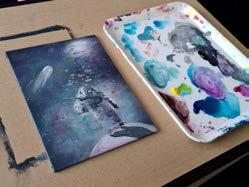
Artwork by Noël C. Baker
When you realized those pieces were generated images, was your perspective or appreciation of the artwork altered? Do you think it matters how transparent artists are about their use of tools in creating art?
My first reaction was, oh, well, this isn’t nearly as good as I originally thought. I was very impressed by it considering what I thought in the beginning, which was that it’s a pure watercolor artwork. I was very impressed at their imagination and use of colors and details. It was just mind-blowing when I found out it was generated by AI; my first emotional reaction was disappointment.
And then my second one was that I wanted to try to recreate that! I wanted to figure out exactly which AI tool they used and exactly which inputs they used. I wanted to get exactly what they made, and through experimentation, I actually got pretty close, but not exact. So that was satisfying to me; it was almost like a game to try to figure out how they did it.
But does that mean it has less value? Again, instinctively, my first reaction is to say yes, because the amount of time it takes and the amount of work they put in to generate AI is a lot less than someone who was doing it traditionally. But does it have less value to the people who see it, and are inspired by it, and enjoy looking at beautiful watercolor paintings, and maybe buy one and put it on their wall? I’m not sure that it would.
What would you advise another artist curious about generative AI to do?
Play, have fun, explore, be creative, but make sure that what you produce is coming from you, make sure that it’s your creation in the end. That’s what I would tell an artist.

Follow Noël’s work on instagram: @noel.c.baker

Exploring the Future of Engineering
A Conversation with Ole Haaland
Tell us how you’re incorporating generative AI into your work?
A couple of years ago I came across this generative AI tool called GitHub Co-Pilot - it’s a generative AI system which produces code in the language of your choice. I found it extremely useful, and I didn’t want to work without it. I was working in Tesla Autopilot at the time and they had a blanket ban on the tool due to security concerns. But then I started a new job, and luckily they allowed me to use it. But they wouldn’t pay for it.
I kept insisting to management that this is indeed a tool that everyone should be using. I held a presentation on the topic for my department and convinced quite a few colleagues that this is the future. However, it wasn’t until the boom of ChatGPT that my workplace actually started taking these tools seriously.
My manager decided that we needed a task force for approaching this in a system-making manner. I was approached to take part, due to my strong enthusiasm for the topic.
The task force is focused on how we can integrate these tools into the workplace. We’re trying to tackle the problems associated with tool integration and trying to understand what people think about them, what we want to do with them, and how we can use them. The goal is to reach a recommendation of the most helpful and feasible tools.
But we’re also thinking about ethical issues surrounding the use of these tools. Open-sourced solutions like Co-Pilot, or ChatGPT, require us to send all of the data to a server which is outside of our control. So we need to consider ethical questions such as: do we trust these companies with the data? Who owns the code that we generate from these tools?
What is the general perspective of generative AI in the engineering community?
A lot of engineers are quite purist, and rightfully so. They went to university, and dedicated hours of research learning to do things by hand, in an incredibly tedious way. But then, in the real world, you’re usually after quick and simple solutions.
These Generative AI systems can produce a lot of what engineers have spent hours and hours learning in the blink of an eye. And I think a lot of engineers are skeptical about it – they don’t really want to embrace it.
So part of the work I’m doing involves, not just finding the right tools, but convincing people that they should use them.
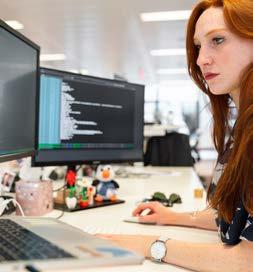
How do you see the role of engineers changing in response to the increased use of generative AI?
I think there are two core aspects to think about here. First, many of the skills we care about aren’t relevant to our work yet. Second, creativity and system thinking will become our most important skills.
So number one is that certain skills might become less needed in the future. At school, spelling and grammar are taught as essential skills in life. Doing well at school, and even passing our exams required us to be good at it. But this might change when generative AI is fully integrated into our lives. Knowing these small nitty gritty details will probably be much less important in the future.
And this goes for legal professionals and programming too. You don’t need perfect spelling because you can just put broken text into Chat GPT and get perfectly corrected text. So many of these skills that you’d need a high level of precision for might not be needed anymore.
But we should keep in mind that these tools aren’t perfect. It’s not just like you can take these tools and make whatever you want. These tools lack the same understanding that engineers have, so they are prone to making the same error again and again. I think this severely cripples ChatGTP’s ability to automate your programming job. Without the ability to correctly respond to and resolve errors, there is simply no way for this system to take your job. Someone still needs to understand what is going on. This is why I think these tools will benefit creative people with the ability to understand complex problems
I think the role of the engineer in the future should be seen more as a composer. Or at least more as a composer than an individual musician. While the individual musician focuses on the small details, the composer focuses on how the whole comes together, they’re working at the level up. For the past 50 years, computer engineering has been changing constantly. At each stage of development it’s become more and more high-level - more abstract. Back in the day, we were creating programs by hand, by using punch cards, and then feeding them into the computer. Many of us were still obsessed with single lines of code, asking how we’d format them. But all of that has now gone out the window. The more and more efficient the programming languages, the less work you have to do. From this perspective, ChatGPT is just a case of tool progression. So, yes, ChatGPT is revolutionary, but it can also be seen as another example of us being able to work at a higher level, where yet more details are abstracted away.
It might feel revolutionary, but we still require an engineer to understand what’s going on. Who knows what it’ll be like in 20 years, but I think it’ll be fascinating to see.

What does the integration of these tools mean for human collaboration?
A lot of the time you just need to know where to look, and how to look for it. And I guess things have already changed in some way. Way back we used to ask stupid questions to our friends, but now we are addicted to the “google it” mentality. But even with google some people are better at finding results than others. And the same is true for prompting ChatGTP in an efficient way. If you don’t know the right question, then you won’t get the right answer.
These tools won’t necessarily solve all your problems, you might need help seeing it from a different perspective.
While ChatGPT will be a valuable tool for that. I still think human collaboration will be necessary. My personal hope is that these tools will make it easier for us to collaborate, instead of discouraging it. I think and hope that these tools will be used in a way that leaves less admin work for us and more time to discuss what we actually care about.
These tools may potentially enhance our communication in the future. For instance, consider an existing email feature that detects and pauses an emotionally charged message before it is sent. Such tools effectively facilitate civil discourse within organizations by promoting better phrasing and tone. Humans can be very rash people, we tend to offend each other and start pointless conflicts. On the other hand, ChatGTP is incredibly averse to conflict and would therefore be a great moderator. So in this way, generative AI might actually aid collaboration.
What other positive implications do you see with generative AI models such as ChatGPT?
At its core, I hope these tools will be a very good positive thing, in that they’ll allow us to do less work, or more work efficiently.
Another thing is that the kind of engineering available to us might be more creative. One incredible thing about ChatGPT is how we can access knowledge without having to dig for stuff. It’s a great tool for educating yourself, and this isn’t necessarily deep knowledge or understanding, but it helps anyone get their foot in the door for any new topic. Both experts and novices can educate themselves with ChatGPT, and this is a great thing.
I’m especially hopeful that these tools will help us manage the information overload that we are exposed to at work. We won’t have to check our emails or five different messaging platforms. Instead, information can be condensed and presented to us in an accessible and simple format.
Given your optimistic tone, I’m wondering what you see as the worst possible situation with the integration of generative AI?
My biggest worry about generative AI boils down to how powerful institutions will make use of them. The most relevant institutions for us in the West are the mega-corporations. Can we really trust these corporations to do the right things with these technologies? At the end of the day, the goal of capitalistic institutions is profit and this is sadly, often not aligned with human flourishing and happiness.
A good example of this is how the attention economy has rapidly changed our civilization. Kids are addicted to their phones and I don’t think we are too many generations away from a world looking like Wall-E. Generative AI will not exactly slow this trend, but rather help get us even more hooked. What happens when AI-generated TikTok becomes the norm? I don’t think it will look too good.
I also worry about how political institutions could misuse this technology. The ability of ChatGPT to create fake content, or fake conversations is really quite impressive. And, in the wrong hands, this capability of ChatGPT is really concerning. It could be deployed to build trust with people, surveil them or detect the possibility of crimes and things like that.
This outcome is something outside of what even George Orwell could imagine. Back in 1984, you just had a camera and a TV. But the applications you can use now to suppress people or control them are really insane.

How has the conversation progressed around generative AI within the engineering community? Is there still the initial fear that systems like ChatGPT are going to take over engineering roles?
I think initially there was a very big hype around it, which is natural. And then there was a sobering period after a couple of weeks, in which people started noticing the flaws in these products. The biggest one is its veracity. Say, you can ask ChatGPT to add 4 and 4 together and it can give you the wrong outcome. Where a 20-year-old calculator would give you the perfect answer.
I wouldn’t be scared – not right now – there are for sure reasons to be scared, and a lot of traits and skills will become redundant, but I don’t think we should fear becoming completely redundant. Yes, ChatGPT can do certain things a hundred times faster than I can. But I don’t think we should be scared of this. It just means that we have to rethink what work is and how we do it. And to me, that’s freedom. I can make more things in a shorter amount of time.
I understand that I have a very optimistic perspective, a lot of people have a much darker take on things. If you are hyper-specialised, and not planning on learning something new over the next 20 years, then yes, I’d be incredibly scared about my future career if I were you. But, if you’re open to new avenues, and doing new things, then I don’t think you need to be scared, you should embrace the change.
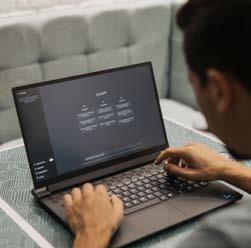
What would you want to say to a fellow engineer who has a more pessimistic view about the change that’s occurring in your profession right now?
For someone who is just coming into the industry, I’d encourage them to adapt, change, and understand the aspects of their role that will change quickly. However, those of us with longterm memory will remember that this has been said many times before. Embracing change has been a winning trait for many years.
And don’t give up on trying to understand things deeply. These tools are exactly that – tools –you shouldn’t be relying on them to pass your exams and to get by in life. Understanding is key to solving novel problems and that is what engineering is all about. If you lose out on this skill then you will lose in the job market. Use ChatGTP to make yourself smarter, not dumber.
For those who are more skeptical. Enjoy doing the boring stuff, the rest of the world will not be waiting around.
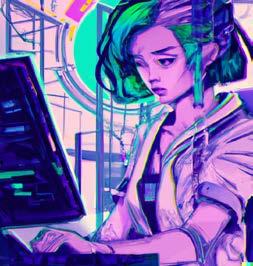
Image generated using DALL-E 2
Prompt: a cyberpunk illustration of a coder creating a new AI system, digital art
At A Glance: Key Takeaways From This Article
• Our roles, skills, and workplaces are likely to change considerably as generative AI is integrated into our day-to-day. This integration will bring with it many benefits, such as increased productivity and efficiency. However, we will need to take steps to mitigate the potentially negative effects of this transition.
• Artists have throughout history been cautious at the emergence of new tools, but, as with any other technology, generative AI can be used in the right way and the wrong way. These technologies do pose threats to some areas of art, in particular digital art. But, generative AI is just another tool, and giving artists the knowledge and ability to use it in the right way can help to foster rather than hinder artistic creativity.
• Many engineers understandably remain sceptical about generative AI. However, we should bear in mind that these tools will never fully replicate the role of the engineer. The engineer has a level of understanding that an AI system will never have. And engineers will still be needed even as these tools develop. By remaining open to this change, and adapting to the changing landscape, engineers can develop alongside these technologies, rather than against them.










